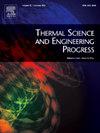Experimental study of the cooling properties of a high-temperature turbine vane with air cooling or steam cooling
IF 5.1
3区 工程技术
Q2 ENERGY & FUELS
引用次数: 0
Abstract
In order to accurately predict the cooling properties of a high-temperature turbine vane to ensure its safe operation, an experimental study was conducted on a turbine vane with smooth cooling channels with air cooling or steam cooling. Combining Response Surface Model (RSM) and Design of Experiments (DOE), the effects of main airflow inlet temperature Tgi, outlet pressure pgo, inlet/outlet pressure ratio pr, (steam or air)/main airflow temperature ratio Tr and flow ratio times 100 Mr on the cooling efficiency ε, normalized temperature η and thermal unevenness ζ of the turbine vane with air cooling or steam cooling were investigated. Furthermore, the cooling performance of the blade was numerically investigated using the SST k-ω turbulence model and a correlation equation describing the cooling properties of the turbine vane was constructed based on the RSM. The influence of coupling effect of the operating parameters on the cooling properties of the turbine vane was further investigated based on correlation equation. The results show that the correlation equation obtained by the RSM provides a high degree of accuracy. The distribution trends of the cooling properties of the turbine vane with air cooling or steam cooling are similar. However, under the same operating conditions, the mean cooling efficiency εave, thermal unevenness ζ and mean normalized temperature ηave for steam cooling are approximately 15.1%, 22.6% higher, and about 2.3% lower compared to air cooling, respectively. Furthermore, the numerical method of fluid–solid coupling heat transfer can accurately simulate the heat transfer characteristics of the blade channel.
空气冷却或蒸汽冷却高温涡轮叶片冷却性能的实验研究
为了准确预测高温涡轮叶片的冷却性能,保证其安全运行,对风冷和蒸汽冷却两种光滑冷却通道的涡轮叶片进行了实验研究。结合响应面模型(RSM)和试验设计(DOE),研究了风冷或蒸汽冷却时,主气流进口温度Tgi、出口压力pgo、进出口压力比pr、(蒸汽或空气)/主气流温度比Tr和流量比100 Mr对涡轮叶片冷却效率ε、归一化温度η和热不均匀性ζ的影响。在此基础上,采用SST k-ω湍流模型对叶片的冷却性能进行了数值研究,并基于RSM建立了描述叶片冷却性能的相关方程。基于相关方程,进一步研究了工作参数耦合效应对涡轮叶片冷却性能的影响。结果表明,该方法得到的相关方程具有较高的精度。空气冷却和蒸汽冷却时涡轮叶片冷却性能的分布趋势相似。但在相同工况下,蒸汽冷却的平均冷却效率εave、热不均匀度ζ和平均归一化温度ηave分别比空冷高15.1%、22.6%和2.3%左右。此外,流固耦合换热数值方法可以准确模拟叶片通道的换热特性。
本文章由计算机程序翻译,如有差异,请以英文原文为准。
求助全文
约1分钟内获得全文
求助全文
来源期刊

Thermal Science and Engineering Progress
Chemical Engineering-Fluid Flow and Transfer Processes
CiteScore
7.20
自引率
10.40%
发文量
327
审稿时长
41 days
期刊介绍:
Thermal Science and Engineering Progress (TSEP) publishes original, high-quality research articles that span activities ranging from fundamental scientific research and discussion of the more controversial thermodynamic theories, to developments in thermal engineering that are in many instances examples of the way scientists and engineers are addressing the challenges facing a growing population – smart cities and global warming – maximising thermodynamic efficiencies and minimising all heat losses. It is intended that these will be of current relevance and interest to industry, academia and other practitioners. It is evident that many specialised journals in thermal and, to some extent, in fluid disciplines tend to focus on topics that can be classified as fundamental in nature, or are ‘applied’ and near-market. Thermal Science and Engineering Progress will bridge the gap between these two areas, allowing authors to make an easy choice, should they or a journal editor feel that their papers are ‘out of scope’ when considering other journals. The range of topics covered by Thermal Science and Engineering Progress addresses the rapid rate of development being made in thermal transfer processes as they affect traditional fields, and important growth in the topical research areas of aerospace, thermal biological and medical systems, electronics and nano-technologies, renewable energy systems, food production (including agriculture), and the need to minimise man-made thermal impacts on climate change. Review articles on appropriate topics for TSEP are encouraged, although until TSEP is fully established, these will be limited in number. Before submitting such articles, please contact one of the Editors, or a member of the Editorial Advisory Board with an outline of your proposal and your expertise in the area of your review.
 求助内容:
求助内容: 应助结果提醒方式:
应助结果提醒方式:


